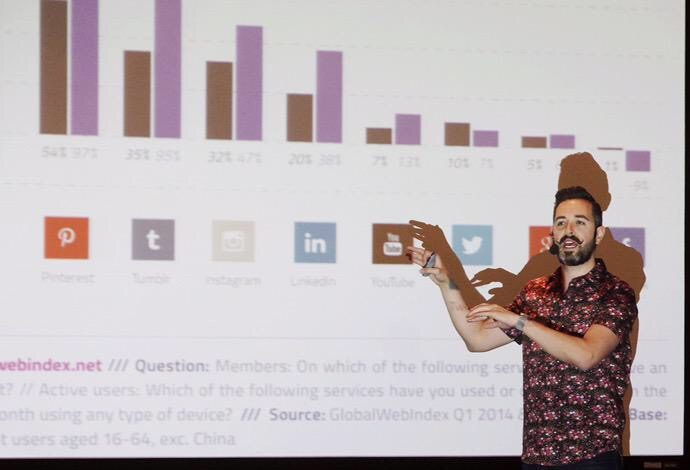Posts Tagged "Personalized Marketing"
Articles
- Best Marketing Conference Sponsorship
- What Does it Mean to Be an Exhibitor at a Conference?
- What Is the Biggest Social Media Conference?
- What Is an Innovation Conference?
- What Is a Typical B2B Event?
- What Are the Cloud Technology Events in 2025?
- Marketing Event Volunteer Opportunities: A Comprehensive Guide
- Digital Marketing Event Volunteer Opportunities Near Me
- What Does a Volunteer Do at a Conference?
- Is DigiMarCon Worth It?
- Is DigiMarCon Good?
- What is the Biggest Marketing Forum?
- What are Digital Marketing Conferences?
- Marketing Conference Exhibiting: Your Guide to Success
- Digital Summit Comparison: A Closer Look at DigiMarCon
- Digital Marketing Conference
- Digital Marketing Events: Your Guide to Success in 2025
- Marketing Conferences: Unlocking Your Business Potential in 2025
- What Is The Future of Digital Marketing in 2030?
- B2B Event Marketing Strategy: Unlocking Success For Your Business
- Why B2B Event Marketing?
- What Should a B2B Marketing Strategy Include?
- Top Marketing Conferences for 2025
- What Is the Future of Marketing in 2025?
Digital Marketing Conferences
- NORTH AMERICA
- DigiMarCon Cruise
(New Orleans, LA, USA) - DigiMarCon West
(Los Angeles, CA, USA) - DigiMarCon Northwest
(Seattle, WA, USA) - DigiMarCon Canada West
(Vancouver, BC, USA) - DigiMarCon Canada
(Toronto, ON, Canada) - DigiMarCon Canada East
(Montreal, QC, Canada) - DigiMarCon Florida
(Orlando, FL, USA) - DigiMarCon Gulf Coast
(Houston, TX, USA) - DigiMarCon Southern California
(San Diego, CA, USA) - DigiMarCon Midwest
(Chicago, IL, USA) - DigiMarCon Mid-South
(Nashville, TN, USA) - DigiMarCon Great Lakes
(Detroit, MI, USA) - DigiMarCon North
(Minneapolis, MN, USA) - DigiMarCon Central
(Kansas City, MO, USA) - DigiMarCon Texas
(Dallas, TX, USA) - DigiMarCon New England
(Boston, MA, USA) - DigiMarCon Mid-Atlantic
(Philadelphia, PA, USA) - DigiMarCon South Florida
(Miami, FL, USA) - DigiMarCon Southeast
(Atlanta, GA, USA) - DigiMarCon Central Florida
(Tampa, FL, USA) - DigiMarCon East
(New York, NY, USA) - DigiMarCon South Atlantic
(Charlotte, NC, USA) - DigiMarCon America
(Washington, D.C. USA) - DigiMarCon Northern California
(San Francisco, CA, USA) - DigiMarCon Rocky Mountains
(Denver, CO, USA) - DigiMarCon South
(San Antonio, TX, USA) - DigiMarCon Silicon Valley
(San Jose, CA, USA) - DigiMarCon Orange County
(Anaheim, CA, USA) - DigiMarCon Southwest
(Phoenix, AZ, USA) - DigiMarCon World
(Las Vegas, NV, USA)
- DigiMarCon Cruise
- LATIN AMERICA
- EUROPE
- MIDDLE EAST
- AFRICA
- ASIA PACIFIC
- DigiMarCon Hawaii & Pacific
(Honolulu, HI, USA) - DigiMarCon Asia & Japan
(Tokyo, Japan) - DigiMarCon New Zealand
(Auckland, New Zealand) - DigiMarCon Australia
(Sydney, Australia) - DigiMarCon Oceania
(Melbourne, Australia) - DigiMarCon Southeast Asia
(Singapore) - DigiMarCon India
(New Delhi, India) - DigiMarCon North Asia & China
(Shanghai, China)
- DigiMarCon Hawaii & Pacific
- VIRTUAL
Digital Marketing Blog
- What Makes DigiMarCon Stand Out (And Is It Worth It?) October 30, 2025
- Is DigiMarCon Worth Attending? A Complete Breakdown October 29, 2025
- DigiMarCon for Startups: Why Founders Shouldn’t Miss It October 29, 2025
- DigiMarCon Recap: What Went Down and What’s Next October 29, 2025

































Personalized Customer Journeys: Tailored Experiences, Increased Profits
In today’s digital world, businesses are looking for ways to improve customer experience and boost sales. One key strategy is to offer experiences that match each customer’s unique needs and habits.
Using targeted messaging, companies can make customers happier, which leads to more profits. This method helps businesses connect with their audience in a personal way. It builds loyalty and supports long-term growth.
Let’s dive into Personalized Customer Journeys. We’ll look at their advantages and share tips on how to use them to increase your return on investment.
The Shift from Mass Marketing to Individual Experiences
The marketing world has changed a lot. Now, it focuses on personalized customer experiences instead of the old one-size-fits-all way. Thanks to data analytics and journey mapping, companies can really get to know their customers. They can then make their marketing more tailored.
This change is all about making real connections with customers. It makes their customer experience better. With data analytics, companies learn what customers like and what they struggle with. This helps them make their marketing more focused.
Journey mapping is key in this shift. It lets businesses see how customers move through different points of contact. This helps spot where they can improve and offer more personalized experiences. These experiences can make customers more engaged and loyal.
So, companies are leaving behind old mass marketing methods. They’re moving towards a more personal approach that speaks to their audience. This change isn’t just about using new tech. It’s about really understanding the customer and adding value at every step of their journey.
What Are Personalized Customer Journeys?
Personalized customer journeys change how businesses talk to their customers. They offer experiences that fit each person’s needs. This is done by using user segmentation and CRM integration. This way, companies can guide customers through their buying journey, making them more engaged and loyal.
At its heart, a personalized customer journey is about knowing what the customer likes and needs. It gives them content and offers that matter to them. This makes customers happier and helps businesses grow by getting more sales and keeping customers longer.
Key Components of Personalized Journeys
With these important parts, businesses can make personalized customer journeys. These journeys not only meet but also go beyond what customers expect. This leads to lasting loyalty and more money for the business.
The Direct Link Between Personalization and Profit
Companies can greatly increase their revenue by using targeted messaging, omnichannel marketing, and automation. Personalization is more than just a marketing term. It really makes a difference in a company’s profits.
To see this impact, businesses need to focus on customer-centric strategies. These strategies should meet each customer’s unique needs and actions. Omnichannel marketing makes sure customers have a smooth experience everywhere, from emails to stores. This unity builds loyalty and boosts sales.
Targeted messaging is key in personalization. It sends the right content to the right people at the right time. With automation, businesses can handle big personalization tasks well, keeping customer interactions high-quality.
Research shows that personalized experiences can greatly increase sales and keep customers coming back. By using data to personalize, companies can connect deeply with their customers. This connection leads to more profits.
Building Your Data Foundation
To make personalized customer journeys work, businesses need a strong data base. They must use data analytics and CRM integration. This helps them understand what customers like and do.
A good data base is key for many reasons. It lets businesses collect and analyze customer data from many places. This gives a full picture of how customers interact with them. It also makes it easy to mix data from different places, like social media and customer feedback.
The main parts of a strong data base are:
With a solid data base, businesses can:
In short, having a strong data base is essential for personalized customer journeys. By using data analytics and CRM integration, businesses can really get to know their customers. This leads to happier customers and more business growth.
Customer Journey Mapping for Personalization
Customer journey mapping is key to personalization. It helps businesses see how customers interact with them at different points. This way, companies can spot where customers might struggle or where they can engage more.
Creating a good journey map means collecting data from many places. This includes what customers say, what they buy, and their social media activity. This data helps make a detailed map of the customer’s path, showing where personal touches can make a big difference.
Best Practices for Journey Mapping
To make journey mapping work well, follow these tips:
By following these best practices and using journey mapping for personalization, businesses can offer more engaging experiences. This leads to happier customers and more sales. As companies keep working on personalizing for their customers, making accurate and useful journey maps is more important than ever.
Advanced User Segmentation Strategies
The secret to great personalization is advanced user segmentation strategies that use data analytics. By dividing customers into detailed groups, companies can make their messages and offers fit each person’s needs. This makes the customer experience better.
Advanced user segmentation is more than just basic info like age or location. It includes things like how customers act, what they buy, and more. This way, companies can send targeted messaging that really speaks to each group. This boosts engagement and sales.
Leveraging Data Analytics for Segmentation
Data analytics is key in advanced user segmentation. By looking at customer data, companies can spot trends and likes that help shape their strategies. This method makes sure segments are right and useful, leading to better personalization.
Using advanced user segmentation, companies can get customers more involved, boost sales, and grow their revenue. As the digital world keeps changing, the need for smart segmentation will keep growing.
CRM Integration: The Backbone of Personalized Journeys
The key to a great personalization plan is strong CRM integration. It links CRM systems with other marketing tools. This way, businesses can make a single customer profile. They can then offer personalized experiences everywhere.
CRM integration helps manage customer interactions and data well. It gives a complete view of each customer. This is key for knowing what customers like and need, making personalization better.
With a full CRM system, businesses can automatically collect and analyze customer data. This makes marketing efforts more focused and relevant. Customers get content and offers that match their interests, improving their customer experience.
This leads to better personalization plans, more customer engagement, and loyalty. By using Personalized Customer Journeys, businesses can build stronger connections with customers. This can lead to more profits and growth over time.
Automation and AI in Customer Journey Personalization
Automation and AI are changing how businesses personalize customer experiences. They help companies deliver tailored experiences on a big scale. By using these technologies, businesses can automate simple tasks. This lets them focus on creating more complex and targeted messaging campaigns.
Automation is key in making personalization work. It helps businesses quickly sort through lots of customer data. This lets them spot patterns and preferences, making experiences more personal. AI takes it a step further by analyzing how customers behave and adjusting marketing plans as needed.
Automation and AI also help predict what customers might do next. They spot when customers might leave or when they might buy more. By using predictive analytics, companies can tweak their marketing to keep customers engaged and boost sales.
To use automation and AI well, businesses need strong data and advanced analytics. With these tools, they can make marketing campaigns that really work. This leads to more profits and happier customers.
Omnichannel Personalization Strategies
Unlocking customer loyalty starts with effective omnichannel personalization. Businesses can make the customer journey more cohesive and engaging. This leads to higher profits.
Omnichannel personalization means giving customers the same great experience everywhere. This includes social media, email, mobile apps, and stores. First, businesses need to know what their customers like and do on these platforms.
Key Strategies for Omnichannel Personalization:
These strategies help businesses offer a personalized experience. For example, a customer who leaves their cart on a mobile app might get a reminder email. This email could have a special offer to finish the purchase. It makes the customer happy and boosts sales.
To improve omnichannel personalization, companies can use AI and machine learning. These tools help predict what customers will like and do next. This way, businesses can stay ahead and build strong customer relationships.
Crafting Targeted Content That Drives Conversion
In today’s market, making content for each customer is crucial for success. Targeted messaging helps businesses talk directly to their customers. This makes the customer experience better.
First, companies need to know what their customers like and do. They use journey mapping to find key moments for personalized content. This content can really help.
By using these methods, businesses can make their customer experience more engaging. This leads to more conversions and higher revenue. Good journey mapping means content is shared at the best time, making it more effective.
Measuring ROI of Personalized Customer Journeys
It’s key to measure the ROI of personalized customer journeys to make smart decisions. By using data analytics and CRM integration, businesses can see how personalization affects their profits.
To get a clear picture of ROI, companies need to watch important metrics. These include conversion rates, how much it costs to get a new customer, and how much a customer is worth over time. A marketing expert said, “It’s vital to measure personalization’s success to prove it’s worth the cost.”
This shows how deep personalization can be.
Good measurement means combining data from all touchpoints and using advanced analytics. This helps businesses improve their personalization plans. It makes their marketing more effective, leading to better ROI.
By focusing on data-driven personalization and always checking its results, businesses can stay ahead. As customer expectations change, being able to adjust personalization strategies will be more important than ever.
Conclusion: Future-Proofing Your Personalization Strategy
As the marketing world keeps changing, businesses need to keep up. By focusing on the customer and using new tech, companies can make Personalized Customer Journeys that lead to lasting success.
To make your strategy future-proof, build a strong data base for omnichannel marketing. This way, you can give customers a smooth experience everywhere, making their journey better.
Use advanced ways to segment users, link your CRM, and automate. This helps you make content that really speaks to your audience. It’s also key to see how your personalized journeys are helping your business.
As you go forward, stay flexible and ready to change your plan. This is because consumer habits and tech are always shifting. By being adaptable, you’ll be ready to offer Personalized Customer Journeys that help your business grow and thrive in a tough market.
FAQ
What is the primary goal of creating personalized customer journeys?
The main goal is to make customers more engaged and boost sales. This is done by tailoring experiences to what each customer likes and does.
How do businesses benefit from adopting a personalized marketing approach?
Businesses see more happy customers, keep them longer, and make more money. It’s all about making customers feel valued.
What role does data analytics play in creating personalized customer journeys?
Data analytics is key to knowing what customers like and do. It helps businesses make experiences that really speak to each customer.
How does CRM integration support personalized customer journeys?
CRM integration helps manage how businesses talk to customers. It makes sure every interaction is smooth and personal.
What is the significance of user segmentation in personalization?
User segmentation lets businesses group customers by who they are. This makes marketing more focused and effective.
How can automation and AI enhance customer journey personalization?
Automation and AI help make experiences more tailored and efficient. They handle the routine stuff so businesses can focus on the personal touches.
What is omnichannel personalization, and why is it important?
Omnichannel personalization means giving customers a consistent experience everywhere. It makes the journey smoother and more enjoyable.
How can businesses measure the ROI of their personalized customer journeys?
Businesses can track the ROI by using data and CRM tools. This shows how personalization affects their profits.
Conversational Marketing: The Future of Customer Engagement
The way businesses talk to customers is changing a lot. Conversational Marketing is leading this change, making how brands connect with people better.
Now, businesses can have personalized, real-time talks with customers. This makes their interactions more meaningful. It also helps build loyalty and boosts sales.
Key Takeaways
What is Conversational Marketing?
Conversational Marketing is a big change in how companies talk to people. It’s all about having a real conversation, not just talking at people. This makes talking to customers more personal and quick.
Definition and Core Principles
At its heart, Conversational Marketing is about talking back and forth between companies and customers. It’s all about real-time engagement and putting the customer first.
Real-Time Engagement
Being able to talk back right away is key in Conversational Marketing. It helps build trust and makes customers happier.
Customer-Centric Approach
This approach makes sure the talk is all about what the customer wants. It makes the conversation more interesting and relevant.
How It Differs from Traditional Marketing
Conversational Marketing is a big move from old ways of marketing. It changes from just talking to actually having a conversation. And it changes what customers expect.
From Broadcasts to Dialogues
Unlike old marketing, which was one-way, Conversational Marketing is a two-way street. It makes talking more fun and interactive.
Shift in Customer Expectations
Now, customers want talks that are personal and quick. Conversational Marketing gives them real-time messaging and journeys that fit them.
By using Conversational Marketing, companies can make deeper connections with their customers. This leads to more engagement and loyalty.
The Evolution of Customer Engagement
Customer engagement has changed a lot. It moved from broad marketing to personal talks. This change comes from history and new tech.
From Mass Marketing to Personalized Conversations
Historical Context
Old marketing aimed at many with one message. But, it missed the personal touch. This led to a gap between companies and their customers.
Technology-Driven Changes
New digital tools have helped in targeting better. Data analytics and AI help understand what customers like. This makes marketing more personal.
The Digital Transformation of Customer Interactions
Mobile-First Communication
Mobile devices have changed how we talk to customers. Now, businesses focus on mobile-friendly sites and responsive design. This makes interactions smooth.
Omnichannel Expectations
Customers want a consistent experience everywhere. This includes social media, email, phone, and in-store. Meeting these omnichannel expectations keeps customers happy and loyal.
Key Components of Conversational Marketing
The way we talk to customers has changed a lot. Conversational marketing is all about making these interactions better. It uses key parts to make sure every chat is personal and smooth.
Real-Time Messaging
Real-time messaging is key in conversational marketing. It lets businesses talk to customers right away. This part has two main things:
Instant Response Capabilities
Being able to answer quickly is very important in conversational marketing. It makes sure customers get help fast, which makes them happier and more engaged.
24/7 Availability
Being open 24/7 through real-time messaging is great. It lets customers talk to businesses anytime. This makes their experience better and helps them feel closer to the brand.
Intelligent Chatbots
Intelligent chatbots are very important too. They use AI to understand and answer customer questions well. Chatbots can be simple or very smart, depending on how they’re made.
Rule-Based vs. AI-Powered Solutions
Rule-based chatbots follow set rules to answer. But AI-powered chatbots learn and change to fit what customers say. This makes their experience more personal and fun.
Conversation Flow Design
Creating a good conversation flow is key for chatbots. It’s about making a chat that makes sense and helps the customer. It should guide them smoothly through their visit.
Personalized Customer Journeys
Personalized customer journeys are the core of conversational marketing. They make sure each customer gets a visit that fits them perfectly.
Data-Driven Personalization
Using customer data helps make visits more special. This data-driven personalization makes chats more interesting and relevant for the customer.
Context Awareness
Context awareness is very important for personal visits. It’s about knowing what the customer is doing right then. This helps give answers that are just right for them.
The Power of Conversational AI
Conversational AI is changing how we talk to customers. It makes interactions more natural and helpful. This change comes from big steps forward in several areas.
Natural Language Processing Advancements
Conversational AI’s strength is in its Natural Language Processing (NLP). NLP lets chatbots and virtual assistants get what we mean. This makes talking to them feel more like talking to a person.
Understanding Customer Intent
AI can figure out what customers really want. It does this by looking at the whole message, not just the words. This means it can give answers that are right on point.
Handling Complex Queries
AI can handle tough questions and multi-step requests. This makes it easy for customers to get help. It’s great for businesses that want to support their customers fully.
Machine Learning and Adaptive Responses
Machine Learning (ML) is key to Conversational AI. It lets systems learn from talking to people and get better at answering.
Learning from Interactions
AI gets smarter over time by learning from past talks. This helps it give better answers in the future. It makes talking to AI a better experience.
Continuous Improvement
AI keeps getting better as it talks to more people. It gets better at understanding what customers need and want.
Sentiment Analysis and Emotional Intelligence
AI also knows how to read emotions. It uses sentiment analysis and emotional intelligence to understand and respond to feelings.
Detecting Customer Mood
AI can tell how customers are feeling by looking at what they say and how they say it. This lets AI respond in a way that feels more caring.
Appropriate Response Calibration
Then, AI adjusts its answers to match the customer’s mood. This makes the conversation feel more personal and supportive.
These technologies make Conversational AI a powerful tool for businesses. By using NLP, ML, and understanding emotions, companies can have better conversations with their customers.
Implementing Conversational Marketing Strategies
To start conversational marketing, businesses need a solid plan. This plan should match their goals for engaging with customers. It’s important to know what customers want and how they behave to tailor marketing efforts.
Developing a Conversational Framework
Creating a conversational framework is key. It’s the base for all interactions with customers. This ensures that every touchpoint feels connected and consistent.
Mapping Customer Touchpoints
It’s vital to map where and how customers interact with the brand. This includes websites, social media, and more. The goal is to make every interaction smooth and seamless.
Creating Conversation Flows
Designing the dialogue between customers and the brand is crucial. It needs to be based on understanding what customers want and need. The brand must respond in a way that feels personal and relevant.
Choosing the Right Platforms and Tools
Picking the right tools is essential for effective conversational marketing. This includes messaging platforms, chatbots, and more. These tools help make customer interactions personal and effective.
Website Integration Options
Adding conversational marketing tools to websites is important. This can include chatbots and live chat. These features allow for real-time engagement with customers.
Social Media Messaging Platforms
Social media platforms are great for conversational marketing. They let businesses talk to customers in real-time. This helps with support, inquiries, and building brand awareness.
Integration with Existing Marketing Channels
Conversational marketing works best when it’s part of a bigger marketing plan. This means connecting it with CRM systems, email platforms, and more. It helps make marketing efforts more cohesive.
CRM Connection
Linking conversational marketing with CRM systems is beneficial. It gives businesses access to customer data. This leads to more personalized experiences, which can boost satisfaction and loyalty.
Email Marketing Synergy
Combining conversational marketing with email marketing is smart. It makes marketing more effective and cohesive. This approach can improve how well customers engage and convert.
Chatbots: The Frontline of Conversational Marketing
Chatbots are changing how we talk to customers. They are key in making marketing more personal and effective.
Types of Chatbots for Different Business Needs
There are many chatbots for different business needs. Customer Service Bots help with customer questions and support. Lead Generation Bots collect information from potential customers to help sales teams.
Customer Service Bots
These bots solve customer problems and answer common questions. They make customers happier and help businesses respond faster.
Lead Generation Bots
Lead generation bots talk to potential customers. They help qualify leads and pass them to sales teams for more work.
Designing Effective Chatbot Conversations
Creating great chatbot conversations needs personality development and conversation branching. A good chatbot should match the brand’s voice and tone.
Personality Development
Creating a chatbot’s personality means making it relatable to the audience. This makes talking to the chatbot more fun and engaging.
Conversation Branching
Conversation branching lets chatbots change their answers based on what users say. This makes conversations more personal and interesting.
Measuring Chatbot Performance
How well a chatbot does is measured in different ways. This includes engagement metrics and resolution rates.
Engagement Metrics
Engagement metrics show how users interact with chatbots. This includes how many conversations start and how long they last.
Resolution Rates
Resolution rates show how often chatbots solve customer problems on their own. This means customers don’t always need to talk to a human.
Creating Conversational User Experiences (UX)
Conversational User Experience (UX) is changing how businesses talk to customers. It makes interactions more natural and personal. This leads to better experiences for everyone.
Designing for Dialogue Rather Than Monologue
Good conversational UX means moving from one-way talks to real conversations. It’s about understanding what the user wants and answering them right.
Conversational Interface Principles
Key principles include being clear, brief, and understanding the context. Interfaces should get and answer user inputs in a way that feels natural.
User Flow Optimization
Improving user flow means making conversations smooth and goal-focused. This is done through smart routing and flexible responses.
Balancing Automation with Human Touch
Automation is important for growing, but human interaction is key for complex or emotional talks. Finding the right mix is essential.
Handoff Protocols
Clear handoff protocols are important. They make sure humans can take over when automation can’t.
Escalation Strategies
Good escalation strategies are key for solving tough problems. They help figure out when and how to escalate issues.
Accessibility Considerations in Conversational Interfaces
Accessibility is vital for making conversational UX for everyone. It means designing interfaces that work for all, no matter their abilities.
Inclusive Design Practices
Inclusive design looks at a wide range of user needs and abilities. It includes designing for people with disabilities and those in different situations.
Alternative Interaction Methods
Offering different ways to interact, like voice or text, makes things more accessible and enjoyable.
Measuring Success in Conversational Marketing
Conversational marketing shines when its success is clear and can be acted upon. Businesses need to track several important areas to see if their strategies work.
Key Performance Indicators
Businesses use key performance indicators (KPIs) to understand how well they connect with customers.
Conversation Completion Rates
One key KPI is the conversation completion rate. It shows how often chats finish without needing a human.
Response Time Metrics
How fast a business answers customer questions is also crucial. It affects how happy customers are.
Conversion Rate Optimization
Improving conversion rates is key to measuring success in conversational marketing. This means turning chats into sales.
Qualifying Leads Through Conversation
Good conversations help businesses find the best leads. This means sales teams can focus on the most promising prospects.
Sales Attribution Models
Using sales attribution models helps businesses see how chats help their sales. This leads to smarter decisions.
Customer Satisfaction Metrics
Metrics like CSAT and NPS show how happy customers are. They help businesses understand and improve customer loyalty.
CSAT and NPS Integration
Adding CSAT and NPS to marketing strategies helps businesses know how to make customers happier.
Qualitative Feedback Analysis
Looking at what customers say in detail helps businesses understand what customers want. This makes marketing better.
By tracking these metrics and improving their marketing, businesses can better engage with customers. This leads to more conversational sales.
Case Studies: Successful Conversational Marketing Campaigns
Real-world examples show how effective conversational marketing can be. Many businesses have used it to improve customer interaction and boost sales.
B2C Success Stories
In the B2C world, conversational marketing shines. Brands have used chatbots and messaging to offer personalized experiences.
Retail and E-commerce Examples
An e-commerce giant saw a 30% increase in sales with a chatbot. It suggested products based on what customers looked at.
A retail brand also used AI to give personalized discounts. This led to a big jump in customer loyalty.
Service Industry Applications
A service company improved its customer service with conversational marketing. A chatbot cut response times by 50%, making customers happier.
B2B Applications
Conversational marketing works well in B2B too. It helps qualify leads better.
Lead Qualification Processes
A B2B company’s AI tool boosted qualified leads by 40%. It asked the right questions to understand clients’ needs.
Account-Based Marketing Integration
Another B2B business combined conversational marketing with ABM. This led to more personalized engagement and higher conversion rates.
Lessons Learned from Industry Leaders
Industry leaders have shared key insights on successful conversational marketing campaigns.
Common Success Factors
These elements are crucial for campaign success.
Pitfalls to Avoid
Don’t be too pushy, as it can harm the customer experience. It’s important to balance value and promotion.
Future Trends in Conversational Marketing
Conversational marketing is on the verge of big changes. Voice-first interactions and augmented reality conversations are leading the way. As businesses use more conversational AI, they aim to create better, more personal experiences for customers.
Voice-First Interactions
Voice-first interactions are gaining popularity fast. This is thanks to the rise of smart speakers and voice assistants. This trend is expected to keep growing, changing conversational marketing a lot.
Smart Speaker Integration
Using smart speakers in marketing can really engage customers. Businesses can use voice commands for smooth interactions. This makes it easier for customers to use their services.
Voice Search Optimization
As more people use voice assistants, optimizing for voice search is key. It’s about using natural language and long-tail keywords that match how we speak.
Augmented Reality Conversations
Augmented reality (AR) is set to change conversational marketing. It offers immersive experiences. AR can improve customer support and make visual commerce more engaging.
Visual Commerce Applications
Visual commerce uses AR to let customers try products virtually. This can make customers happier and reduce returns. It helps them understand products better.
Immersive Customer Support
AR can also make customer support more immersive. For example, customers can see solutions to problems or talk to virtual agents.
Predictive Conversational Intelligence
Predictive conversational intelligence is a big step forward in AI. It lets businesses meet customer needs before they ask. This improves the customer experience a lot.
Anticipating Customer Needs
Businesses can guess what customers want using data and AI. This lets them engage more personally and proactively.
Proactive Engagement Models
Proactive models reach out to customers before they need help. This is made possible by AI and predictive analytics. It leads to happier customers and more loyalty.
Key Takeaways:
Conclusion: Embracing the Conversational Future
Businesses must now adopt Conversational Marketing strategies to keep up with changing customer needs. They can use real-time messaging, smart chatbots, and tailored customer paths. This approach helps create deep, engaging interactions that boost Customer Engagement and Conversational Sales.
The future of customer interaction is all about smooth, natural conversations between brands and their audience. As tech gets better, Conversational Marketing can change how businesses talk to customers. By embracing this change, companies can build stronger, more meaningful connections with their customers.
To thrive in this new world, businesses need to be open to changing their marketing ways. This openness can help them fully use Conversational Marketing and achieve lasting success.
FAQ
What is Conversational Marketing?
Conversational Marketing focuses on talking to customers in real-time. It uses chatbots and AI to make conversations personal and drive sales.
How does Conversational Marketing differ from traditional marketing?
It’s all about talking to customers, not just broadcasting messages. This way, businesses can understand what customers need and respond personally.
What are the key components of Conversational Marketing?
It includes real-time messaging, smart chatbots, and personalized customer journeys. Together, they create a smooth and engaging experience for customers.
How do chatbots fit into Conversational Marketing?
Chatbots are key in Conversational Marketing. They handle customer interactions, offer quick answers, and help qualify leads.
What is the role of AI in Conversational Marketing?
AI is essential for chatbots, using natural language and machine learning. It helps businesses understand what customers want and respond emotionally.
How can businesses measure the success of their Conversational Marketing efforts?
Success can be measured by tracking things like how many conversations are completed and how fast responses are. Also, look at conversion rates and how happy customers are.
What are some best practices for implementing Conversational Marketing strategies?
Start with a clear plan, choose the right tools, and make sure they fit with your marketing. Always look for ways to improve the customer experience.
What are some future trends in Conversational Marketing?
Expect more voice interactions, augmented reality chats, and smart predictive conversations. These will change how businesses talk to customers and succeed.
Unlock the Power of Humanized AI Marketing
The marketing world is changing fast, thanks to AI technologies. These tools help make customer experiences more personal and engaging. As companies try to stand out online, humanized AI marketing is becoming more popular.
Marketers use AI-driven insights to craft campaigns that really speak to their audience. This mix of tech and creativity is changing how brands talk to their customers. It makes their interactions more meaningful and successful.
Key Takeaways
Understanding Humanized AI Marketing
AI is changing marketing, and Humanized AI Marketing is key for businesses. It balances tech and empathy. It’s not just about using AI for speed, but also for making real connections with customers.
Defining the Concept and Core Principles
Humanized AI Marketing uses personalized marketing with AI. It uses data and AI to understand what customers like. The goal is to make marketing more human-centered, focusing on what customers need and feel.
The Intersection of Technology and Human Touch
In Humanized AI Marketing, human-centered AI technology is vital. It uses AI to analyze customer data and then adds human insight. A marketing expert says, “The future of marketing is combining human creativity with AI’s power.”
The Business Case for Humanized AI Marketing
Humanized AI marketing changes how companies talk to their customers. It offers personalized experiences on a big scale. This way, businesses can better engage with customers, build loyalty, and grow.
Measurable ROI and Performance Metrics
One big plus of humanized AI marketing is its ability to show clear ROI and performance. AI marketing campaigns can be watched and studied in real-time. This lets businesses see how well they’re doing and make smart choices based on data.
Key Performance Indicators (KPIs) for AI Marketing:
Competitive Advantages in the Digital Landscape
Humanized AI marketing gives businesses a leg up in the digital world. By using AI to understand customers, companies can make marketing that really speaks to their audience. This sets them apart from the competition.
Cost-Efficiency and Resource Optimization
AI marketing automation makes marketing smoother, cutting down on manual work and mistakes. This saves money and makes resources go further.
By using humanized AI marketing, businesses can change their marketing game. They can boost engagement and grow their revenue. As the digital world keeps changing, using AI in marketing will be key to staying ahead.
Key Technologies Powering Humanized AI Marketing
At the heart of Humanized AI Marketing are advanced technologies. These technologies are changing the marketing world. They help businesses make marketing more personal, engaging, and effective.
Natural Language Processing (NLP) and Understanding
NLP is key in Humanized AI Marketing. It lets machines understand and interpret human language. This is crucial for ethical AI in digital marketing that respects customer wishes and feelings.
Sentiment Analysis and Emotional Intelligence
Sentiment analysis is part of NLP. It helps marketers see how customers feel from their interactions. This insight leads to more caring and responsive marketing, making customers happier.
Conversational Marketing Applications
Conversational marketing, powered by NLP, makes real-time, human-like talks between brands and customers. This tech is vital for making customer experiences unique and improving engagement.
Machine Learning and Predictive Analytics
Machine learning algorithms look at lots of data to guess what customers might want or need. This guessing is key for marketing that’s proactive and on target. It helps businesses stay ahead in a tough market.
Computer Vision in Marketing Applications
Computer vision tech lets us analyze and understand visual data. It’s used for cool marketing stuff like visual search and product recognition. This tech opens up new ways to engage and personalize for customers.
By using these key technologies, businesses can make marketing strategies that work well and are ethically sound. This builds trust and loyalty with their customers.
Personalization at Scale: The AI Advantage
Thanks to advanced AI, personalizing marketing is now possible on a large scale. Humanized AI marketing lets businesses give tailored experiences to many people.
Dynamic Content Generation and Delivery
AI can create and send dynamic content instantly. This means businesses can make personalized marketing campaigns that speak to each customer’s likes and actions.
Behavioral Analysis and Responsive Marketing
AI systems can deeply analyze how customers behave. This lets marketers send targeted campaigns. Behavioral analysis helps understand what customers want, making marketing more effective.
Creating Authentic Customer Journeys
AI helps marketers create real customer journeys. These journeys are both personal and relevant to the customer’s needs. It’s about knowing what the customer needs now and what they might need later.
Micro-Moment Marketing Opportunities
AI lets businesses grab micro-moment marketing chances. These are key moments when customers look for info or act. It’s about giving the right content at the right time.
Cross-Channel Personalization Strategies
Using cross-channel personalization strategies makes sure customers get a consistent, personalized experience. This is true whether it’s through email, social media, or websites.
In summary, AI has changed personalization in marketing. It lets businesses give tailored experiences to many. By using humanized AI marketing and personalized marketing with AI, companies can improve customer engagement and loyalty.
Ethical Considerations in AI-Powered Marketing
Ethical AI is key for businesses today. As AI helps engage customers, companies face many ethical challenges.
Privacy Concerns and Data Protection
Data privacy is a big issue in AI marketing. Marketers must follow laws like GDPR and CCPA. Transparent data practices help build trust with customers.
Transparency in AI Decision-Making
AI makes more decisions on its own, so being open is crucial. Customers should know how their data is used. Explainable AI helps achieve this, building trust and accountability.
Avoiding Algorithmic Bias and Discrimination
AI can show biases if trained on biased data. To avoid discrimination, marketers should regularly audit their AI systems. This ensures diverse training data, preventing ethical issues and improving marketing.
Building Customer Trust Through Ethical AI Practices
Using ethical AI helps businesses build strong customer relationships. Key practices include being open about data use and ensuring AI decisions are clear. These actions meet regulations and boost customer loyalty.
Embracing ethical AI leads to more effective, customer-focused campaigns. These campaigns engage customers without losing integrity.
Implementing Humanized AI Marketing Strategies
To use humanized AI marketing, businesses need to know their current marketing setup. They must look at what they’re good at, what they need to work on, and where they can grow.
Assessment and Strategic Planning
Understanding where AI can help the most is key. This means checking out customer data, marketing methods, and current tech.
Identifying High-Value AI Applications
It’s important to pick AI tools that match marketing goals. This could be making content more personal, predicting what customers want, or automating content.
Setting Realistic Implementation Timelines
Having clear timelines helps manage expectations and resources. It’s about breaking down the process into smaller steps.
Technology Selection and Integration
Choosing the right AI tech is vital. Businesses should look at different AI options, thinking about how well they fit, grow, and get support.
It’s also important to make AI work well with current marketing systems. This might mean working with IT to make sure data and systems work together smoothly.
Team Training and Organizational Adaptation
AI marketing needs a team that knows how to use AI tools. Training should focus on building the right skills.
By planning well, choosing the right tech, and training the team, businesses can use AI marketing to get real results.
Real-World Applications and Success Stories
Human-centered AI technology has changed marketing for many companies. It helps create personalized experiences, improve marketing, and grow businesses. This technology is a game-changer.
E-commerce Personalization Breakthroughs
E-commerce sites use AI for better shopping experiences. For example, Amazon suggests products based on what you’ve looked at and bought. This makes shopping more fun and increases sales.
Content Marketing Optimization and Delivery
AI is changing content marketing. HubSpot uses AI to make and share content that reaches the right people. This leads to better marketing and more return on investment.
Customer Service and Experience Enhancement
AI chatbots and virtual assistants are changing customer service. Companies like Domino’s Pizza use AI for quick, personal help. This makes customers happier and more loyal.
Predictive Lead Scoring and Qualification
AI helps predict which leads are most promising. Marketo uses AI to score leads based on their actions. This makes marketing more focused and effective.
These stories show how AI marketing can help businesses succeed. As AI gets better, we’ll see even more ways it can help in marketing.
Overcoming Challenges in AI Marketing Adoption
Businesses face many challenges when they start using AI marketing. They need to deal with technical, organizational, and data issues. These are key to making AI work well in marketing.
Technical Barriers and Practical Solutions
One big challenge is getting AI tools to work with what you already have. Using modular AI solutions can help. Also, training your employees can fill the technical gap.
Addressing Organizational Resistance
Getting everyone on board is another big challenge. To overcome this, create a culture that values innovation. Explain how AI marketing can help your business. Getting your team involved can also ease their worries and gain their support.
Budget Considerations and Phased Implementation
Money can be a big issue when it comes to AI marketing. A phased implementation approach can help manage costs. It lets you start small and show the value of AI before spending a lot.
Data Quality and Integration Issues
Good data is key for AI marketing success. Make sure your data is accurate and complete. Focus on data cleansing and integration to get the most out of AI marketing.
Future Trends in Humanized AI Marketing
The future of marketing is all about humanized AI. It promises more personalized and immersive experiences for everyone. Several key trends are shaping the industry as we look ahead.
Emerging Technologies and Capabilities
Advances in natural language processing (NLP) and machine learning are making AI marketing tools smarter. These technologies give us deeper insights into what people like and do. This helps us create better marketing plans.
A recent study found that using AI in marketing boosts customer engagement and sales. “AI is not just a tool, it’s a game-changer in how we approach marketing,” says a top marketing expert.
Evolving Consumer Expectations and Behaviors
People now want personalized experiences from brands. Humanized AI marketing meets this need by using data for tailored interactions. As people’s behaviors change, AI’s role in understanding and responding to these changes will be key.
Integration with Immersive Marketing Channels
The growth of augmented reality (AR) and virtual reality (VR) opens up new marketing chances. Humanized AI can make these experiences more interactive and fun.
The Growing Importance of Voice and Visual Search
With more voice assistants and visual search tools, marketers need to adjust. Humanized AI helps make content work well for these new ways of searching. This keeps brands visible and competitive.
As these trends grow, businesses that use humanized AI marketing will connect better with their audience. By keeping up with new tech, marketers can make their campaigns more meaningful and effective.
Conclusion: Embracing the Human-AI Partnership in Marketing
Humanized AI marketing is changing how businesses talk to their customers. It mixes AI’s power with a personal touch. This way, marketers can make campaigns that are tailored, quick, and effective.
The future of marketing is all about working together with AI. Technologies like natural language processing and machine learning make customer experiences better. Think about how humanized AI marketing can help you reach your goals, like better customer engagement and smarter marketing spending.
By using humanized AI marketing, companies can lead the way. They can offer new and impactful marketing strategies that connect with their audience. As marketing keeps changing, combining human creativity with AI will be crucial for success.
FAQ
What is Humanized AI Marketing, and how does it differ from traditional marketing automation?
Humanized AI Marketing blends AI’s efficiency with a personal touch. It creates unique and engaging experiences for customers. Unlike old marketing automation, it uses NLP and machine learning to make content and respond to customers on the fly.
How can AI-powered marketing strategies improve customer engagement?
AI marketing boosts engagement by offering personalized experiences and predicting what customers need. It also allows for real-time interactions. Tools like sentiment analysis help marketers understand and connect with customers on an emotional level.
What are the key technologies driving Humanized AI Marketing?
Key technologies include NLP, machine learning, predictive analytics, and computer vision. These tools help marketers analyze data, create dynamic content, and craft immersive experiences that connect with their audience.
How can businesses ensure ethical AI practices in their marketing efforts?
Businesses should be transparent about AI decisions, protect customer data, and avoid bias. These steps help build trust and keep a good reputation.
What are some common challenges in adopting AI marketing, and how can they be overcome?
Challenges include technical hurdles, resistance, and data quality. To tackle these, invest in training, use a phased approach, and focus on improving data.
How can Humanized AI Marketing be applied in e-commerce personalization?
It can be used for dynamic content, analyzing behavior, and responsive marketing. This helps e-commerce sites offer tailored experiences, boosting loyalty and sales.
What role does AI play in predictive lead scoring and qualification?
AI is key in scoring and qualifying leads by analyzing data and behavior. This helps businesses focus on the most promising leads, improving sales.
How will emerging technologies shape the future of Humanized AI Marketing?
New tech like voice and visual search, immersive marketing, and advanced NLP will shape Humanized AI Marketing. Businesses that adopt these will lead in delivering new customer experiences.